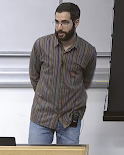
Matthew Lamm
I am a Research Scientist in Google Brain. My focuses include question answering, explainability and interpretability, attribution, and the philosophy and ethics of generative language systems.
Authored Publications
Google Publications
Other Publications
Sort By
Measuring Attribution in Natural Language Generation Models
Iulia Turc
Computational Linguistics, vol. 49 (2023), pp. 777-840
Preview abstract
With recent improvements in natural language generation (NLG) models for various applications, it has become imperative to have the means to identify and evaluate whether NLG output is only sharing verifiable information about the external world. In this work, we present a new evaluation framework entitled Attributable to Identified Sources (AIS) for assessing the output of natural language generation models, when such output pertains to the external world. We first define AIS and introduce a two-stage annotation pipeline for allowing annotators to appropriately evaluate model output according to AIS guidelines. We empirically validate this approach on generation datasets spanning three tasks (two conversational QA datasets, a summarization dataset, and a table-to-text dataset) via human evaluation studies that suggest that AIS could serve as a common framework for measuring whether model-generated statements are supported by underlying sources. We release guidelines for the human evaluation studies.
View details
Retrieval-guided Counterfactual Generation for QA
Bhargavi Paranjape
Proceedings of the 60th Annual Meeting of the Association for Computational Linguistics (Volume 1: Long Papers), Association for Computational Linguistics (2022), pp. 1670-1686 (to appear)
Preview abstract
Deep NLP models have been shown to be brittle to input perturbations. Recent work has shown that data augmentation using counterfactuals — i.e. minimally perturbed inputs — can help ameliorate this weakness. We focus on the task of creating counterfactuals for question answering, which presents unique challenges related to world knowledge, semantic diversity, and answerability. To address these challenges, we develop a Retrieve-Generate-Filter(RGF) technique to create counterfactual evaluation and training data with minimal human supervision. Using an open-domain QA framework and question generation model trained on original task data, we create counterfactuals that are fluent, semantically diverse, and automatically labeled. Data augmentation with RGF counterfactuals improves performance on out-of-domain and challenging evaluation sets over and above existing methods, in both the reading comprehension and open-domain QA settings. Moreover, we find that RGF data leads to significant improvements in a model’s robustness to local perturbations.
View details
LaMDA: Language Models for Dialog Applications
Aaron Daniel Cohen
Alena Butryna
Alicia Jin
Apoorv Kulshreshtha
Ben Zevenbergen
Chung-ching Chang
Cosmo Du
Daniel De Freitas Adiwardana
Dehao Chen
Dmitry (Dima) Lepikhin
Erin Hoffman-John
Igor Krivokon
James Qin
Jamie Hall
Joe Fenton
Johnny Soraker
Maarten Paul Bosma
Marc Joseph Pickett
Marcelo Amorim Menegali
Marian Croak
Maxim Krikun
Noam Shazeer
Rachel Bernstein
Ravi Rajakumar
Ray Kurzweil
Romal Thoppilan
Steven Zheng
Taylor Bos
Toju Duke
Tulsee Doshi
Vincent Y. Zhao
Will Rusch
Yuanzhong Xu
arXiv (2022)
Preview abstract
We present LaMDA: Language Models for Dialog Applications. LaMDA is a family of Transformer-based neural language models specialized for dialog, which have up to 137B parameters and arepre-trained on 1.56T words of public dialog data and web text. While model scaling alone canimprove quality, it shows less improvements on safety and factual grounding. We demonstrate thatfine-tuning with annotated data and enabling the model to consult external knowledge sources canlead to significant improvements towards the two key challenges of safety and factual grounding.The first challenge, safety, involves ensuring that the model’s responses are consistent with a set ofhuman values, such as preventing harmful suggestions and unfair bias. We quantify safety using ametric based on an illustrative set of values, and we find that filtering candidate responses using aLaMDA classifier fine-tuned with a small amount of crowdworker-annotated data offers a promisingapproach to improving model safety. The second challenge, factual grounding, involves enabling themodel to consult external knowledge sources, such as an information retrieval system, a languagetranslator, and a calculator. We quantify factuality using a groundedness metric, and we find that ourapproach enables the model to generate responses grounded in known sources, rather than responsesthat merely sound plausible. Finally, we explore the use of LaMDA in the domains of education andcontent recommendations, and analyze their helpfulness and role consistency.
View details
QED: A Linguistically Principled Framework for Explainable Question Answering
Eunsol Choi
TACL (2021)
Preview abstract
A question answering system that in addition to providing an answer provides an explanation of the reasoning that leads to that answer has potential advantages in terms of debuggability, extensibility, and trust. To this end, we propose QED, a linguistically informed, extensible framework for explanations in question answering. A QED explanation specifies the relationship between a question and answer according to formal semantic notions such as referential equality, sentencehood, and entailment. We describe and publicly release an expert-annotated dataset of QED explanations built upon a subset of the Google Natural Questions dataset, and report baseline models on two tasks—post- hoc explanation generation given an answer, and joint question answering and explanation generation. In the joint setting, a promising result suggests that training on a relatively small amount of QED data can improve question answering. In addition to describing the formal, language-theoretic motivations for the QED approach, we describe a large user study showing that the presence of QED explanations significantly improves the ability of untrained raters to spot errors made by a strong neural QA baseline.
View details
No Results Found
